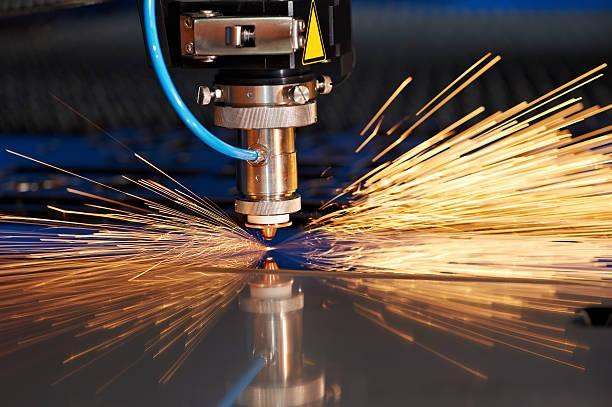Laser technology refers to the process of amplifying light using stimulated emission of radiation. The term “LASER” stands for Light Amplification by Stimulated Emission of Radiation, and it generates a focused beam of coherent light. Unlike regular light, lasers are extremely concentrated and can be directed with high precision.
From medical breakthroughs to industrial manufacturing, laser technology is now the backbone of innovation across numerous fields.
Table: Core Characteristics of Laser Technology
Feature Description Coherence All light waves are in phase and direction Monochromatic Consists of one wavelength High Intensity Can be focused into a narrow and powerful beam Directionality Travels in a straight, tight path without dispersion Tunability Frequency can be adjusted for various applications
Applications of Laser Technology Across Industries
1. Manufacturing and Industrial Processing
- Laser Cutting: Offers unmatched precision for cutting metals, plastics, and glass.
- Laser Welding: Ensures deep penetration and minimal thermal distortion.
- Laser Engraving and Marking: Common in electronics, automotive parts, and jewelry.
Key Data:
- Over 15% of global manufacturing processes use laser cutting or welding systems.
- Fiber lasers are the fastest-growing segment, expected to reach over $6 billion by 2026.
2. Medical and Healthcare Sector
- Laser Surgery: Minimally invasive procedures (e.g., LASIK, cancer cell removal).
- Dermatology Treatments: Skin resurfacing, tattoo removal, and pigmentation treatment.
- Dental Lasers: Used for cavity treatment, gum reshaping, and tooth whitening.
Authoritative Insight:
Studies show laser-assisted surgeries reduce recovery time by 30–50%, improving patient outcomes significantly.
3. Telecommunications and Data Transfer
Lasers enable fiber optic communication, transmitting data at light speed.
- Wavelength-Division Multiplexing (WDM): Multiple signals transmitted over one fiber.
- Low Loss Transmission: Enhanced clarity and range.
Fact: A single laser-powered fiber-optic cable can carry data at up to 1 Gbps or more per channel, making global internet infrastructure more efficient.
4. Military and Defense
- Laser Weapons: Directed energy weapons capable of neutralizing drones and missiles.
- Range Finding and Target Designation: Precision tracking of enemy assets.
- Communication Systems: Secure, high-speed data relay via line-of-sight lasers.
Governments worldwide have invested billions in the development of laser-based defense technologies.
5. Consumer Electronics
- Blu-ray and CD/DVD Players: Use laser beams to read data from discs.
- Laser Printers: Precision printing using static electricity and laser beams.
- 3D Sensing & Facial Recognition: Used in smartphones and AR devices.
6. Research and Development
Lasers play a pivotal role in:
- Quantum Computing
- Spectroscopy
- Astronomy (LIDAR-based terrain mapping)
They help simulate conditions of extreme temperature and pressure, assisting in atomic and molecular research.
Types of Laser Technology
Bullet Points: Most Common Types of Lasers
- Gas Lasers (e.g., CO₂ Lasers): Ideal for cutting and engraving non-metal materials.
- Solid-State Lasers (e.g., Nd:YAG): Common in medical and military applications.
- Fiber Lasers: Compact, energy-efficient, used for marking, cutting, and welding.
- Diode Lasers: Power compact devices like laser pointers and barcode scanners.
- Excimer Lasers: Operate in ultraviolet; used in eye surgeries and semiconductor manufacturing.
Benefits of Laser Technology in Industry
- Speed and Precision: Executes complex operations quickly and with fine detail.
- Non-contact Processing: Reduces mechanical stress on materials.
- Automation Compatibility: Easily integrates with CNC and robotic systems.
- Environmentally Cleaner: Less waste compared to traditional methods.
Laser Safety: What You Need to Know
Laser ClassRisk LevelCommon UseClass 1SafeCD/DVD playersClass 2Low RiskLaser pointersClass 3MediumScientific and research equipmentClass 4HighIndustrial and medical equipment
Important: Protective eyewear and controlled environments are mandatory for Class 3 and Class 4 lasers.
SEO Tip: Targeting Long-Tail Variants
To improve organic reach, consider targeting long-tail keyword variants such as:
- “industrial uses of laser technology”
- “how laser technology works”
- “laser technology in medical field”
These queries often appear in voice searches and rank for featured snippets when structured as FAQs.
Frequently Asked Questions (FAQs)
What is laser technology used for in manufacturing?
Laser technology is widely used for cutting, welding, marking, and engraving materials. It ensures precision, speed, and consistency, especially in metal and automotive industries.
How do lasers work in fiber optics?
Lasers emit highly focused light that travels through optical fibers with minimal loss, enabling high-speed internet and telecommunication networks.
Is laser treatment safe in medicine?
Yes. When conducted by certified professionals using approved equipment, laser treatments are generally safe and offer quicker recovery with less scarring.
What's the difference between fiber and diode lasers?
Fiber lasers offer higher beam quality and efficiency, suitable for industrial applications. Diode lasers are compact and cost-effective, commonly used in electronics.
Which industries benefit most from laser technology?
Manufacturing, healthcare, telecommunications, defense, and research all heavily utilize laser technology for innovation and efficiency.
Interactive Element: Quick Comparison – Laser vs. Traditional Methods
FactorLaser TechnologyTraditional MethodsPrecisionHighMedium to LowSpeedFastModerateWaste ProductionMinimalHighAutomationHighly CompatibleRequires Manual Control OftenInitial CostHigherLowerMaintenanceLowModerate
Voice Search Optimization Suggestions
To increase the likelihood of your content appearing in voice search results, use natural language questions such as:
- “What are the main uses of laser technology today?”
- “How does laser cutting work?”
- “What industries use laser technology the most?”
Structure answers in 50–60 word paragraphs for maximum snippet visibility.
Notable Industry Statistics
- The global laser technology market is projected to hit $25.6 billion by 2027.
- The Asia-Pacific region leads in manufacturing-based laser adoption.
- Laser-based medical procedures have grown by over 20% annually in the last five years.
Semantic Keywords to Include
To ensure better indexing by search engines, incorporate semantically related terms such as:
- Photonic technology
- Laser beam
- Precision optics
- Light amplification
- Industrial laser systems
These keywords align with Google’s NLP processing and help your content rank for a broader range of queries.





Comments